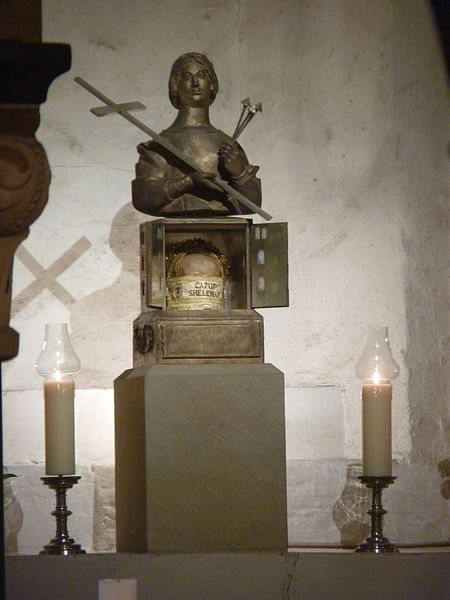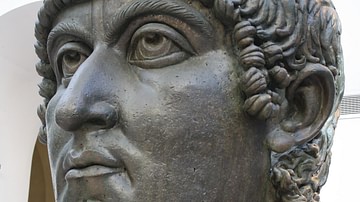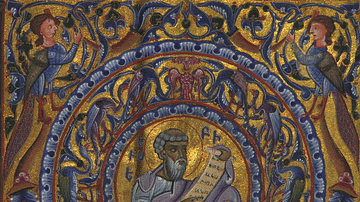
Saint Helena of Constantinople (248/250-328 CE) was the mother of Roman emperor Constantine I (r. 306-337 CE). She famously made a pilgrimage to Jerusalem where tradition claims found Christ's true cross and built the Basilica of the Holy Sepulcher. She is venerated as a saint and considered the patron of archaeologists, converts, difficult marriages, divorced people, empresses, Saint Helena Island, and new discoveries.
Early Life
Helena was born at Depranum (modern Trapani) in Bithynia, which Constantine later renamed Helenopolis in honor of his mother. The exact date of her birth is unknown. Nothing is known about her family, so it is possible to conclude that they were not members of the aristocracy. Some authors claim that Helena was a stabularia, which could either mean a prostitute or a waitress at an inn, which may or may not have been owned by her father.
She met the future emperor Constantius I Chlorus (r. 305-306 CE) in 272 CE, and historians suggest that she became his concubine or wife. In accordance with a Roman law called Lex Julia et Papia Poppaea, Roman nobles could not marry women of lower origins, and so the concubinage hypothesis is widely accepted. The future emperor Constantine I was born from this union ex obscuriore matrimonio, meaning that his parents were not married; he could be considered a bastard son.
Constantius is said to have divorced or repudiated Helena in 293 CE to marry Theodora, daughter of Maximian (r. 286-305 CE), emperor in the West. Diocletian (r. 284-305 CE), emperor in the East, had established the tetrarchy where the Roman Empire was ruled by four people (the eastern and western parts each ruled by an Augustus and a Caesar) and believed that emperors should not only be linked by political ties but also by blood. Therefore, marriages were important to build family relationships and maintain centralized power.
After the separation of Helena and Constantius, Helena disappears from the historical records until 306, when Constantine becomes emperor. It is possible that she lived in Trier or Rome, but the lack of historical information makes this uncertain.
Constantine's Court & Christianity
Constantine became emperor in 306 CE when he was proclaimed Augustus by his troops. He fought civil wars against other emperors – Maxentius and Licinius – and led various campaigns against the Franks and Visigoths, amongst others. The new emperor made Byzantium his capital, giving the city the name New Rome at that time; later, in honor of the emperor, people started to call it Constantinople (modern Istanbul).
In 306 CE, Helena went to live with her son at court. Regardless of her origins or her past, Constantine was very fond of his mother and elevated her to Augusta, which means that she was considered an empress and a holy person.
In the historiography, there is no conclusive proof for Helena's role in Constantine’s conversion to Christianity. Constantine always had great tolerance for Christians, which is why he promulgated the Edict of Milan in 313 CE, ending the persecution that Diocletian had started in 303 CE. When he moved the capital of the empire to Constantinople, he decided to decorate it and began the construction of several temples and also many churches. He preferred the empire's officials to be Christians and made no secret of his preference, but he also employed pagans.
The date of Constantine's conversion is controversial, as many historians claim that his baptism took place only on his deathbed, but it is a fact that Constantine raised his children within the Christian faith. The theory is widely accepted that Helena was a Christian from birth, and when she went to live with her son at court, she influenced him to become a Christian as well. However, according to Eusebius of Caesarea (d. 339 CE), a bishop considered the father of church history, her conversion to Christianity followed Constantine becoming emperor. Whatever the truth, we know that Helena was granted access to the imperial treasury in order to locate the relics of the Christian tradition. In addition, she also built some churches and did charity, helping the poorest. She is often associated with the discovery of the true cross of Christ and the building of churches in Jerusalem.
Pilgrimage to Jerusalem & The Discovery of the True Cross
In 326 CE, Constantine had his son Crispus executed, after the accusation of his wife, Fausta, of an alleged sexual crime. After this, he also ordered that Fausta be murdered on a charge of adultery, as there was a rumor that Fausta had accused Crispus in an attempt to hide his adulterous acts. Some historians claim that Constantine decided to murder Fausta because Helena would have been deeply hurt by the loss of her grandson.
After these events, Helena decided to on a pilgrimage to Jerusalem to distribute alms and build churches, especially in holy places, such as sites of the death and ascension of Jesus Christ. It is in this period that the story for which Helena is best known emerges. The narrative of the discovery of the cross is one of the most important and well-known legends of Late Antiquity, so much so that Jacopo de Varazze, in his 13-century Legenda Aurea, describes the myth about the cross and also states that Helena was considered an exemplary Christian within the Catholic Church.

It is said that while traveling to Jerusalem, Helena found three crosses, one of which was the cross of Christ and also the nails. The legend says that three sick people came, the first touched one of the crosses, the second touched another, but nothing happened until the third person touched the cross of Christ; he was healed as if by a miracle. It is said that at the exact location of the discovery, the Basilica of the Holy Sepulcher was built. The construction of the Church of the Nativity is also attributed to her. The cross of Christ and other relics were in the future the subject of several controversies within the church.
Sainthood
By the time Helena died at the age of 80, c. 328 CE (some sources say 329 and even 330 CE), she was already associated with many monuments in Rome, Bethlehem, and Jerusalem, and was also depicted on many coins. She was buried in the newly built basilica on Via Labicana in Rome, and today her sarcophagus is in the Museo Pio-Clementino in the Vatican.
She became a saint for her accomplishments in the Catholic Church and also for being an example of faith and a model of a woman who brought stability and continuity to the family and dynasties. Helena is venerated as a saint by the Eastern Orthodox, Oriental Orthodox, Eastern and Roman Catholic Churches, as well as by the Anglican Communion and Lutheran Churches. Her alleged skull is displayed in the Cathedral of Trier, Germany. There are also relics at the basilica of Santa Maria in Ara Coeli in Rome, the Église Saint-Leu-Saint-Gilles in Paris, and at the Abbaye Saint-Pierre d'Hautvillers.
Modern Depiction
There is a legend in Great Britain that Helena was the daughter of a King of Britain, named Cole of Colchester, who was an ally of Constantius, but there is evidence of Helena having lived in Britain or being born there. Constantius died in the city of York when Constantine was with him, but in this period, his parents were already separated. It is possible that the story was written to make Helena a British heroine of medieval chivalry romances and to claim her nationality due to her son's connection to the city of York.
The narrative that Helena would be King Cole's daughter appears in a novel written by Louis de Wohl, The Living Wood, published in 1947. Helena also appears in a modern novel, written by author Evelyn Waugh, as its main character. She is also the protagonist of the fantasy work Priestess of Avalon by Marion Zimmer Bradley and Diana Paxson, where she is given the name Eilan. Finally, in 2021, she appeared as a character in Dan Whitfield's Eagle Ascending, where she is portrayed as a woman who lived to be 118 years old, as a result of special powers received after discovering the True Cross.









